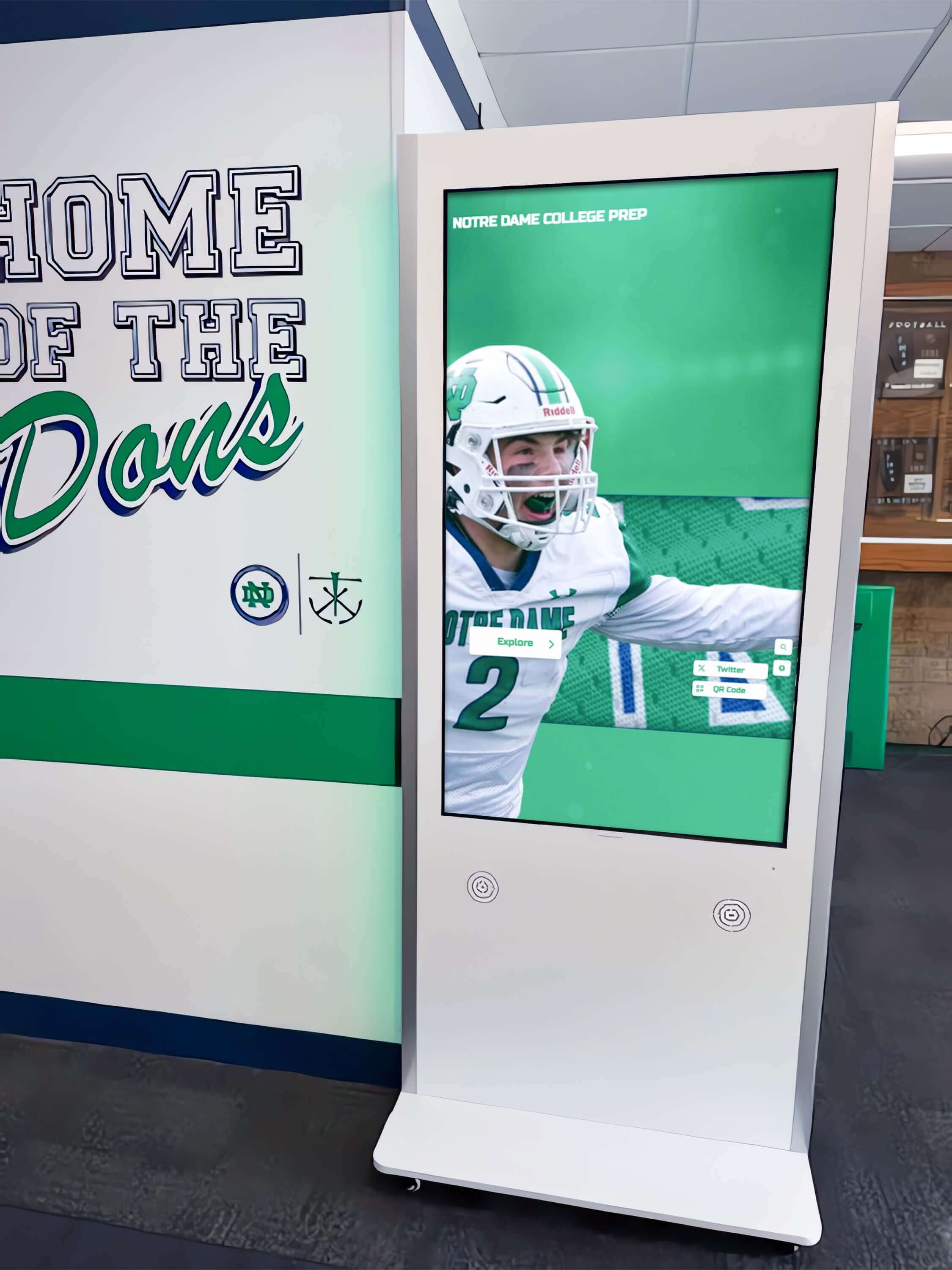Key Takeaways
Explore how interactive timeline displays celebrate Villanova basketball's championship legacy, from the 1985 upset to modern excellence, through engaging digital recognition technology.
The Villanova Basketball Legacy Worth Celebrating
Villanova’s basketball tradition spans over a century, with moments of excellence that define not just the program but college basketball itself. Understanding this legacy’s depth and significance explains why comprehensive recognition matters for current and future generations.
Championship Excellence: Three National Titles
Villanova’s three NCAA championship victories each represent unique moments in college basketball history, memorable for different reasons and celebrated by different generations of Wildcat faithful.
1985: The Perfect Game Against Georgetown
Perhaps no single game in NCAA tournament history receives more recognition as the ultimate underdog story than Villanova’s stunning defeat of Patrick Ewing’s heavily-favored Georgetown Hoyas in the 1985 championship game. Entering as an eighth seed—still the lowest seed ever to win the national championship—Villanova executed what many consider the most perfect offensive performance in tournament history.
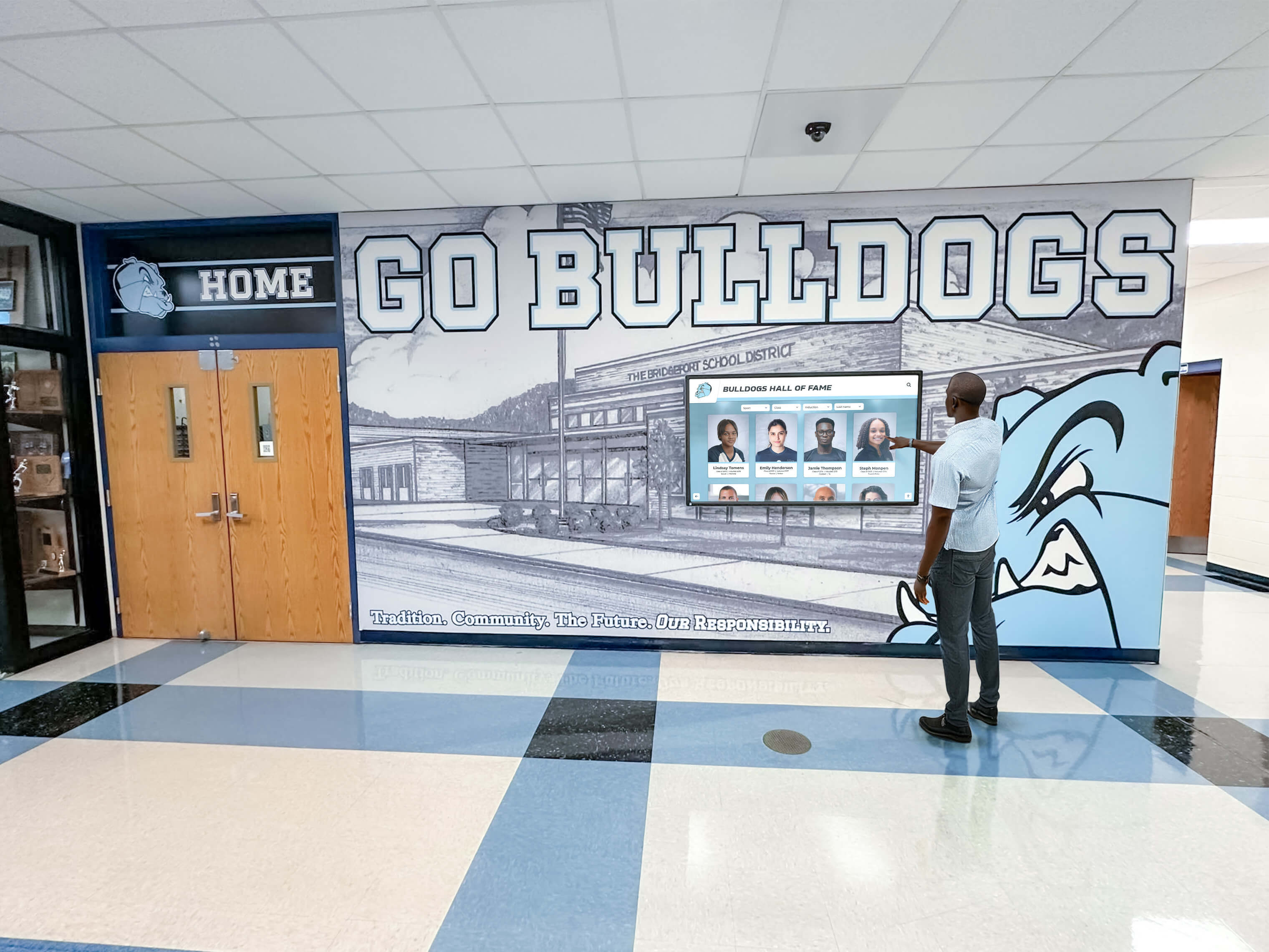
The Wildcats shot an astounding 78.6% from the field, making 22 of 28 field goal attempts, including a remarkable second half where they missed only one shot. This performance against Georgetown’s legendary defense remains unmatched in championship game history. Coach Rollie Massimino’s tactical brilliance combined with clutch performances from players like Ed Pinckney, who was named Most Outstanding Player, created a blueprint for tournament success that basketball programs study decades later.
2016: The Perfect Ending Against North Carolina
After waiting 31 years for another championship opportunity, Villanova delivered perhaps the most dramatic finish in NCAA tournament history. With the game tied against North Carolina and seconds remaining, Ryan Arcidiacono drove and pitched to Kris Jenkins, whose three-pointer at the buzzer secured a 77-74 victory as time expired.
The shot heard around the basketball world gave coach Jay Wright his first national championship and created an instant legendary moment replayed continuously in highlight packages. The 2016 team combined offensive efficiency with defensive excellence, ranking in the top five nationally in both categories—a rare combination demonstrating complete basketball excellence.
2018: Dominant Excellence Against Michigan
Two years after the dramatic buzzer-beater, Villanova returned to dominance with a more comprehensive championship victory. The Wildcats dismantled Michigan 79-62 in a performance showcasing offensive firepower and tactical superiority that left no doubt about which team deserved the title.
Donte DiVincenzo’s 31-point performance off the bench earned him Most Outstanding Player honors while demonstrating the program’s remarkable depth. This championship validated that 2016 was no fluke, establishing Villanova as a modern basketball dynasty under Jay Wright’s leadership.
Beyond Championships: Conference Excellence and Consistent Competition
While national championships define program legacy, Villanova’s sustained excellence across decades demonstrates institutional commitment that transcends individual tournament runs.
The Wildcats have won numerous Big East regular season and tournament championships, maintained consistent NCAA tournament appearances across multiple decades, produced countless NBA players continuing Villanova tradition professionally, and developed players academically with graduation rates consistently exceeding national averages for major basketball programs.
This comprehensive excellence across all dimensions of collegiate athletics represents the full story that interactive timeline displays can celebrate—not just championship moments but the sustained commitment to basketball and academic excellence that defines Villanova’s institutional identity.
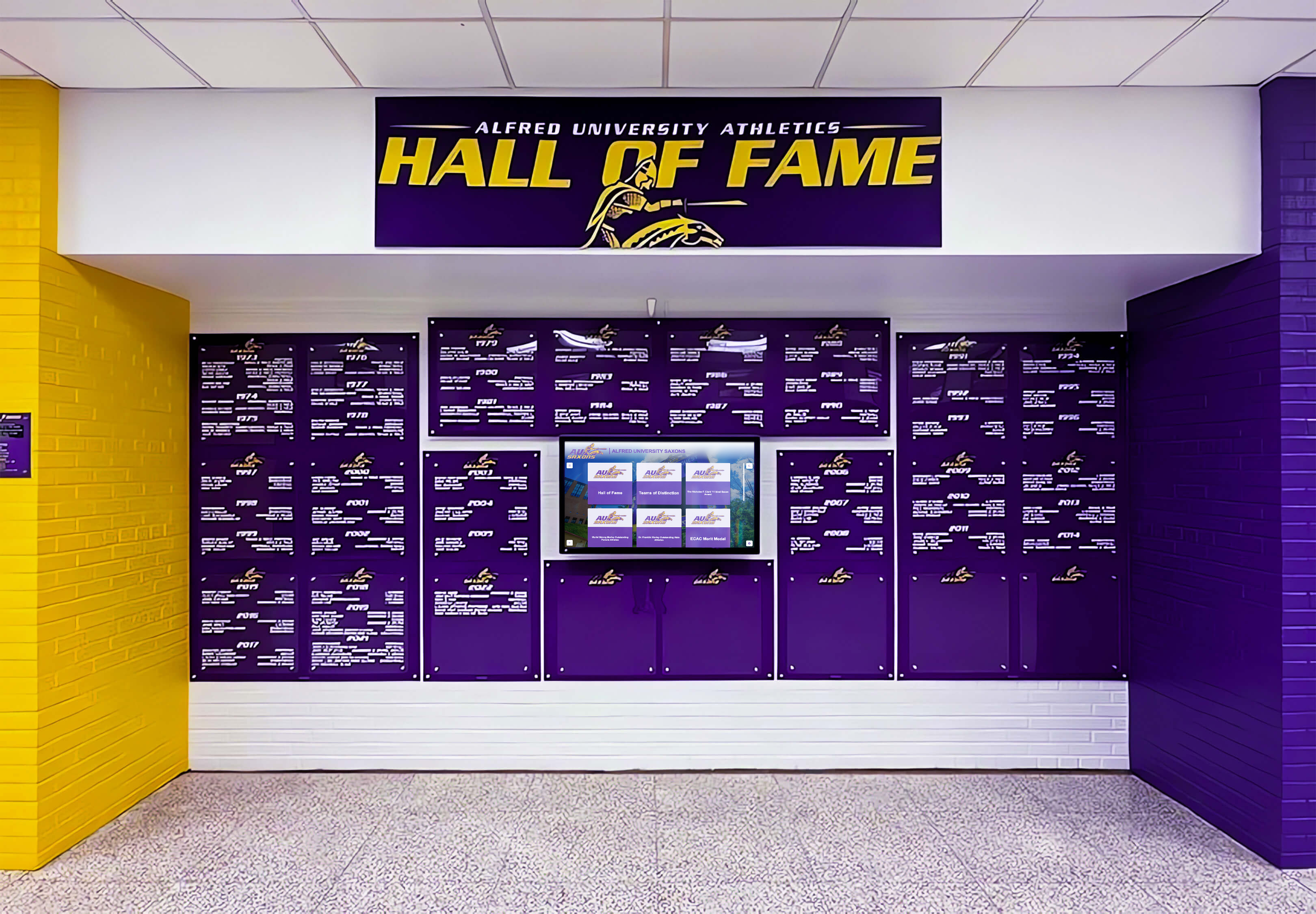
The Challenge of Celebrating Basketball History Traditionally
Athletic departments at elite basketball programs face predictable challenges when attempting to preserve and celebrate comprehensive program histories through conventional recognition methods.
Space Constraints Limit Comprehensive Recognition
Traditional trophy cases and wall-mounted displays face inevitable capacity limitations that force difficult decisions about what achievements deserve visible recognition versus storage in forgotten boxes.
A program as successful as Villanova accumulates hundreds of significant achievements over just a few decades—conference championships across multiple eras, individual player awards and All-American selections, memorable victories against ranked opponents, tournament advancement achievements, and distinguished alumni accomplishments at professional and other levels.
Physical space simply cannot accommodate comprehensive documentation of all these achievements. Traditional displays must prioritize recent accomplishments or highest-level recognition, inevitably leaving most program history invisible to current students, recruits, and visitors.
Static Displays Become Quickly Outdated
Championship banners and engraved plaques create permanent records of specific achievements, but this permanence becomes a liability as programs continue evolving. Adding new accomplishments requires expensive fabrication, professional installation, and often results in inconsistent appearance as additions accumulated over time don’t match original display aesthetics.
Many athletic facilities feature recognition displays that comprehensively cover historical periods but suddenly stop updating several years ago because the ongoing cost and effort of traditional updates became unsustainable. These frozen timelines actually undermine program perception by suggesting that recent teams haven’t achieved recognition-worthy success—obviously false but communicated unintentionally through outdated displays.
Limited Storytelling Capability
Physical plaques convey only basic information—typically names, years, and brief achievement descriptions. This minimal approach fails to tell complete stories that create emotional connections and provide context making achievements meaningful to audiences unfamiliar with specific players or seasons.
What made a particular championship team special? Which players overcame significant obstacles to achieve excellence? How did coaching philosophy evolve across different eras? What memorable moments define specific seasons beyond final tournament outcomes? Traditional recognition methods lack capacity to explore these compelling narratives that transform simple achievement lists into inspiring stories.
How Interactive Timeline Displays Transform Basketball Recognition
Digital recognition technology specifically designed for athletic programs addresses traditional limitations while creating entirely new possibilities for celebrating basketball excellence and engaging diverse audiences.
Unlimited Recognition Capacity
Interactive timeline displays eliminate space constraints entirely, enabling athletic departments to celebrate every significant achievement across complete program histories. A single large touchscreen can showcase comprehensive information about thousands of players, hundreds of memorable games, dozens of championship seasons, and complete statistical records—coverage that would require thousands of square feet of traditional display space.
Solutions like digital school history timeline displays provide platforms specifically designed for comprehensive historical documentation that grows continuously as programs add new achievements each season.
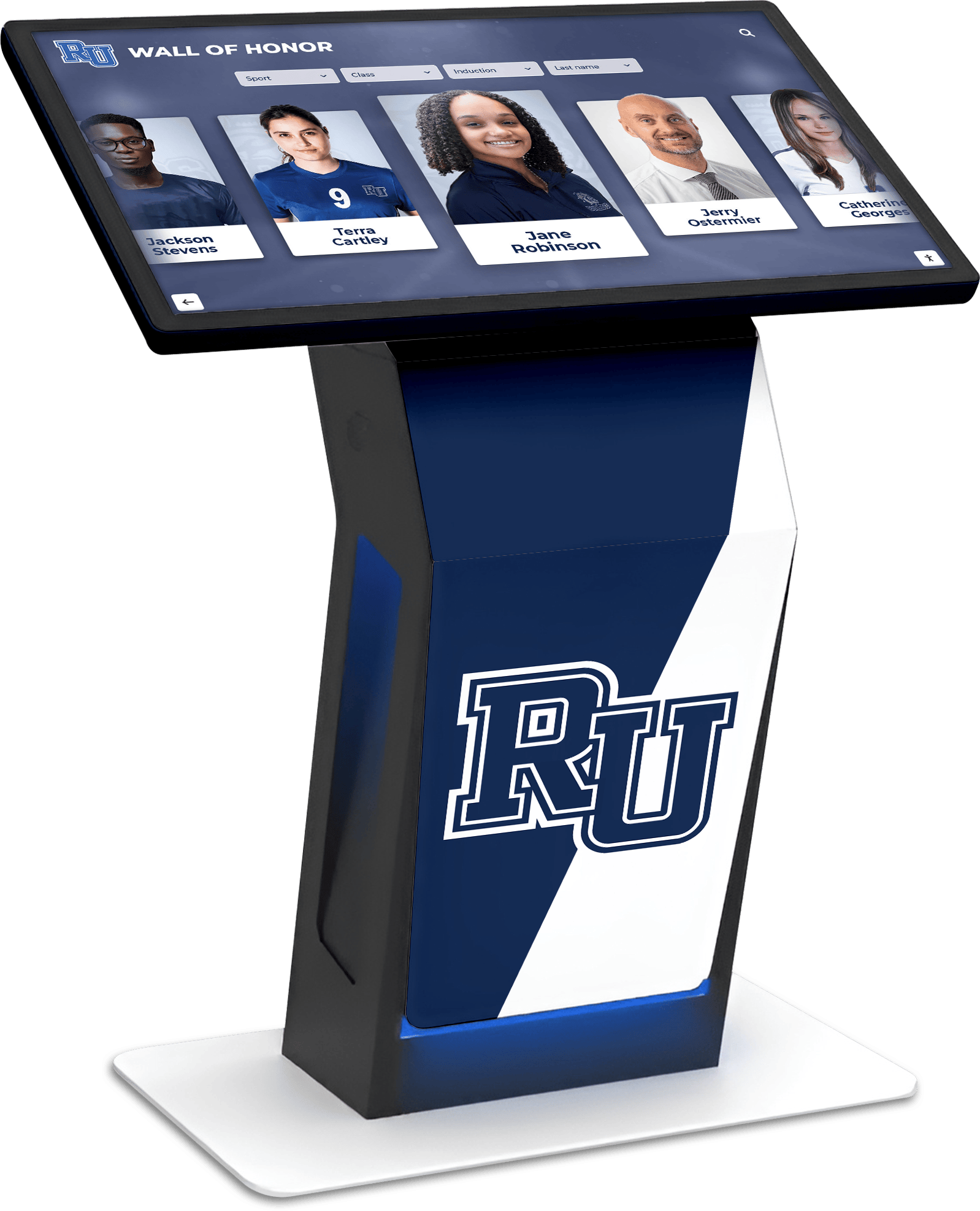
Programs implementing digital timelines can finally recognize every player who contributed to program success, celebrate every memorable victory regardless of ultimate season outcome, document statistical achievements across all eras enabling comparison and context, preserve coaching philosophies and tactical innovations, and maintain comprehensive records that serve research and historical preservation purposes.
Rich Multimedia Storytelling
Digital platforms integrate diverse media types that bring basketball history to life far more effectively than static photos and text alone. Interactive timeline systems combine high-resolution game photography capturing dramatic moments, video highlights from championship games and memorable performances, audio interviews with legendary players and coaches, interactive statistics showing career progressions and records, and digitized historical materials including game programs and newspaper coverage.
This multimedia depth creates emotional engagement impossible with traditional plaques. Recruits watching highlight footage of Kris Jenkins’ championship shot while reading detailed analysis of the play’s execution develop visceral connections to program tradition. Alumni exploring interactive timelines rediscover teammates and memorable games from their own playing days, strengthening emotional bonds that support lifelong engagement.
Interactive Exploration and Personalized Discovery
Static displays force predetermined viewing sequences based on physical arrangement. Digital systems provide sophisticated exploration enabling visitors to search by player name, season, or achievement type, filter to specific eras or championship seasons, browse chronologically or thematically by category, compare statistics across different time periods, and discover connections between teammates and coaching eras.
These capabilities ensure all achievements remain discoverable regardless of when they occurred. A recruit interested in Villanova’s point guard tradition can instantly find every notable player at that position across decades. An alumnus can search for teammates and seasons from their undergraduate years. A basketball historian can compare offensive efficiency statistics across different coaching eras.
Searchability transforms comprehensive historical databases from overwhelming information volumes into personally relevant discoveries tailored to individual interests—dramatically increasing engagement time and emotional impact.
Instant Updates Celebrating Current Excellence
Traditional recognition displays requiring physical fabrication for updates often lag seasons behind current achievements, diminishing recognition’s motivational impact when athletes wait months or years to see their accomplishments celebrated publicly.
Cloud-based content management enables authorized athletic staff to update digital timeline content immediately from any device. When teams achieve conference championships or reach tournament milestones, recognition appears within hours while excitement remains high rather than becoming distant memory by the time physical plaques arrive.
This immediacy transforms recognition from historical documentation into living celebration directly connected to current programs, motivating current players by demonstrating that excellence receives prompt, visible acknowledgment.
Implementing Interactive Basketball Timeline Displays
Successfully creating engaging digital timeline experiences requires systematic planning addressing content development, technology selection, and strategic integration with broader athletic recognition programs.
Content Development: Building Comprehensive Historical Documentation
Comprehensive timeline content begins with systematic research gathering information about program history across all eras.
Historical Research Process
Many athletic programs discover that complete records of historical achievements exist scattered across multiple locations and formats rather than organized systematically. Comprehensive content development requires reviewing yearbook archives documenting past teams and rosters, digitizing game programs and media guides from multiple decades, searching newspaper archives for contemporary game coverage and player profiles, conducting video archive research to locate historic game footage, and interviewing former players, coaches, and staff to capture institutional memory not documented in official records.
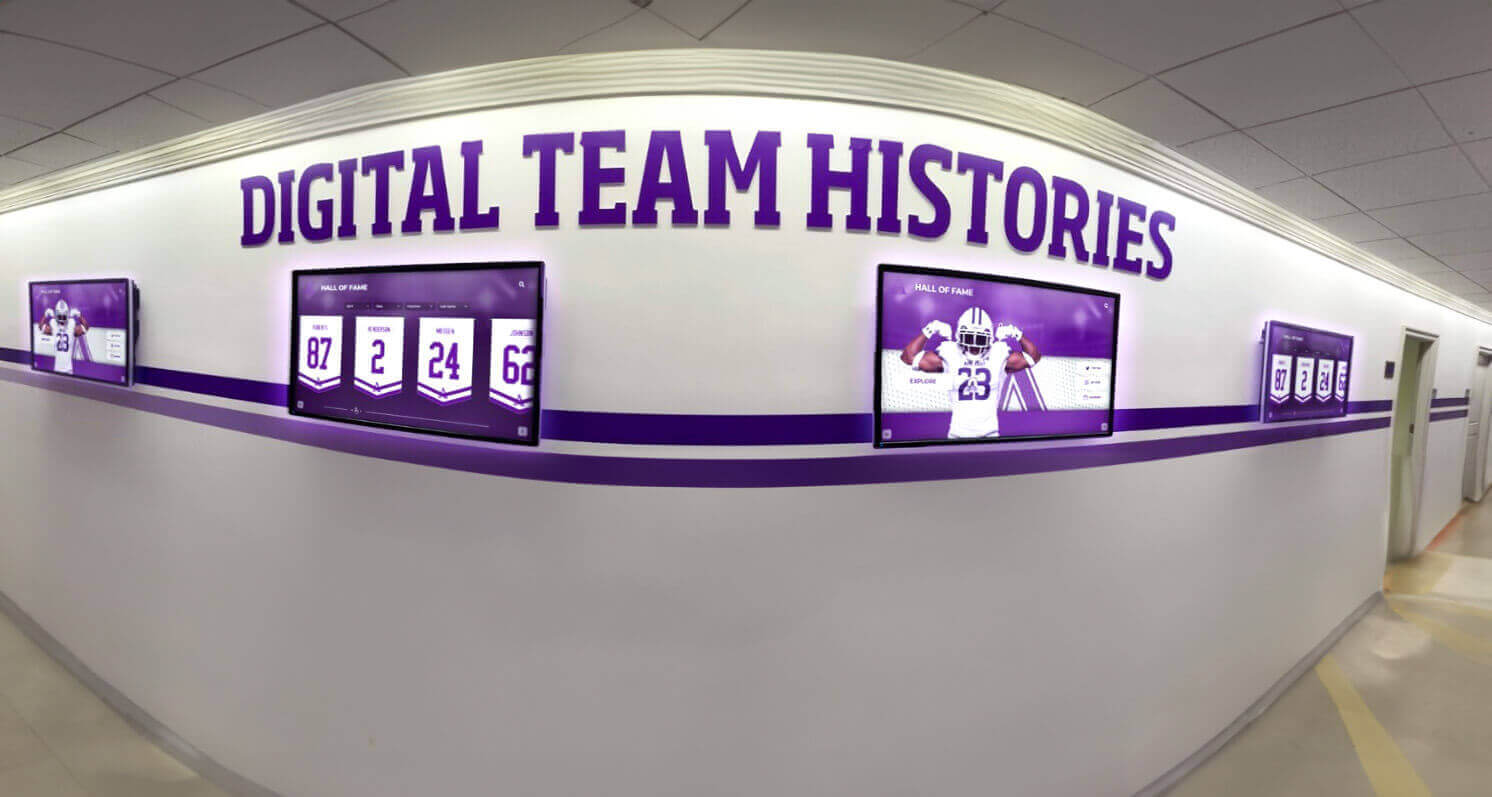
Create systematic inventory documenting season-by-season results and achievements, comprehensive player rosters with biographical information, coaching tenures and career records, significant individual and team milestones, and championship seasons with detailed documentation.
This research commonly takes 2-4 months for programs with strong existing archives and 4-8 months for those requiring extensive detective work reconstructing incomplete records. The investment creates foundational content supporting not just timeline displays but multiple other purposes including media relations, alumni engagement, and recruiting materials.
Content Standards for Consistency
Establish guidelines ensuring professional, consistent results across all timeline entries including minimum required information for each player and season, photography standards and resolution requirements, statistical categories documented consistently across all eras, naming conventions and formatting rules, and verification procedures ensuring accuracy.
Consistent standards ensure digital recognition maintains professional quality appropriately celebrating elite basketball achievement while facilitating effective searching, filtering, and comparison across different time periods.
Platform Selection: Choosing Appropriate Technology
Digital timeline implementations require both display hardware and content management software working together to create compelling user experiences.
Critical Platform Features
Evaluate solutions based on intuitive content management requiring no technical expertise, timeline visualization tools providing multiple viewing options, robust multimedia support for photos, videos, and interactive statistics, powerful search and filtering functionality, mobile-responsive web accessibility extending reach beyond physical installations, analytics tracking engagement patterns and popular content, and reliable technical support and training resources.
Platforms specifically designed for athletic recognition provide purpose-built features that general digital signage systems lack. Solutions like Rocket Alumni Solutions specialize in sports recognition with interfaces optimized for celebrating basketball excellence and engaging both current and prospective student-athletes.
Hardware Considerations
Display hardware decisions impact visibility, engagement, and long-term satisfaction including commercial-grade touchscreens sized appropriately for viewing distance (typically 55-75 inches), high-resolution displays showing detailed statistics and photos clearly, reliable performance under continuous operation in high-traffic areas, and professional mounting options including wall mounting or freestanding kiosks.
Strategic placement in high-visibility locations where recruits, students, and visitors naturally congregate maximizes engagement and recognition impact. Common successful locations include main athletic facility lobbies, basketball practice facility entrance areas, student-athlete academic centers, and arena concourses with game day traffic.
Integration with Recruiting and Development Strategies
Interactive timeline displays serve strategic purposes beyond simply honoring past achievements. Forward-thinking athletic departments integrate timeline recognition into broader institutional priorities.
Recruiting Tool for Prospective Student-Athletes
Championship tradition matters enormously to elite basketball recruits evaluating program options. Interactive timeline displays provide tangible evidence of sustained excellence that recruiting coordinators leverage during campus visits. Prospects can explore position-specific tradition seeing previous point guards or forwards who developed into professional players, watch championship game footage from different eras, review player development statistics showing improvement trajectories, and understand coaching philosophy consistency across successful seasons.
Digital platforms make these integrations seamless and memorable, creating powerful impressions during recruiting visits that differentiate programs with deep tradition from those lacking comparable history. Learn more about college recruiting and athletic recognition strategies that strengthen campus visit experiences.
Development and Alumni Engagement
Former players represent valuable constituencies for athletic fundraising and program support. Interactive timelines strengthen these relationships by publicly celebrating player contributions, providing platforms alumni can share with family and professional networks, facilitating reunion planning by helping locate former teammates, and demonstrating institutional commitment to honoring everyone who contributed to program success.
Development offices report that donor conversations benefit significantly from interactive displays helping prospective donors visualize how philanthropic support enables championship-level programs. When major gifts can be celebrated through featured timeline content, giving becomes participation in continuing tradition rather than isolated transaction.
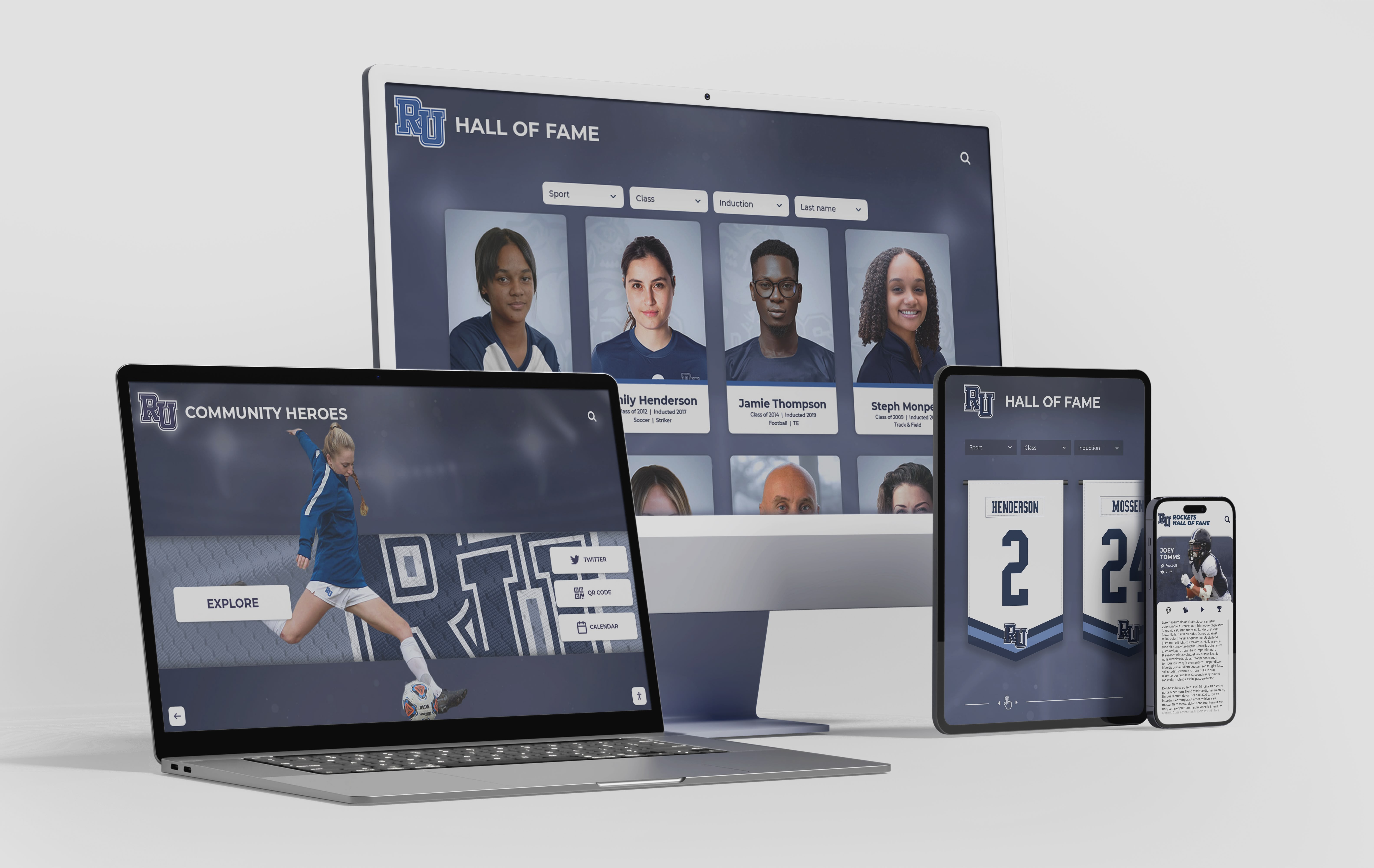
Creating Compelling Basketball Timeline User Experiences
Technology alone doesn’t guarantee engaging timeline experiences. Thoughtful design and content organization determine whether visitors spend seconds glancing at displays or minutes actively exploring program history.
Chronological Timeline Views
The foundation of any basketball timeline involves chronological organization helping viewers understand program evolution across decades.
Effective implementations provide overview timelines showing major championship eras at a glance, decade-by-decade detailed views grouping related achievements, season-by-season navigation for comprehensive exploration, and key milestone highlighting drawing attention to championship moments.
Visual timeline representations with photographs and achievement icons create engaging overview perspectives inviting deeper exploration of specific periods catching viewer attention. Interactive zoom functionality allows quick overview scanning followed by detailed investigation of interesting eras.
Thematic Organization Options
While chronological presentation remains essential, thematic organization options provide alternative navigation pathways aligned with specific interests.
Valuable thematic categories include championship seasons with comprehensive documentation, coaching era comparisons showing different program philosophies, position-specific player histories for recruits researching their roles, Big East conference achievements celebrating conference excellence, and NCAA tournament history documenting March Madness moments.
Multiple organizational schemes operating simultaneously let different users navigate the same comprehensive database through personally relevant entry points—recruits by position, alumni by graduation year, historians by coaching era, and fans by championship season.
Player Profile Pages with Rich Detail
Each player profile should expand beyond roster listings to celebrate complete contributions including comprehensive statistics across career, biographical information and academic achievements, highlight videos showing signature performances, post-graduation accomplishments including professional careers, and memorable quotes or interview excerpts.
Profile depth averaging 200-400 words with multiple photos and video clips when available provides sufficient information to honor contributions meaningfully while keeping content digestible. Featured players with particularly notable achievements can receive expanded coverage approaching 800-1000 words with extensive multimedia integration.
Championship Season Deep Dives
Title-winning seasons deserve particularly comprehensive documentation that helps audiences understand what made specific teams special. Championship season pages should include complete rosters with individual contribution summaries, season narrative describing key victories and turning points, tournament run documentation with game-by-game details, coaching strategy analysis explaining tactical approaches, and video highlights from memorable games throughout the championship run.
For Villanova specifically, dedicated pages for the 1985, 2016, and 2018 championship seasons create destination content that visitors explore repeatedly, sharing discoveries through social media and strengthening emotional connections to program tradition.
Best Practices for Basketball Timeline Success
Implementation approaches separating exceptional timeline experiences from mediocre attempts involve several proven strategies.
Start Comprehensive, Update Continuously
Rather than launching minimal timelines planning to add content eventually, invest in comprehensive initial content covering complete program history. Comprehensive launches create immediate value and demonstrate institutional commitment to honoring all eras rather than only recent achievements.
Once launched, establish systematic update processes ensuring new achievements appear promptly including designated staff responsible for timeline maintenance, coach and athletic communications submission workflows, approval procedures before publication, and regular enhancement cycles improving historical content as new materials emerge.
Balance Statistical Depth with Narrative Storytelling
Basketball naturally generates extensive statistics, but numbers alone don’t create emotional engagement. The most effective timelines balance quantitative achievement documentation with qualitative storytelling that humanizes accomplishments and provides context.
Combine detailed statistical records with coach and player interviews explaining what numbers don’t capture, game narratives describing dramatic moments and turning points, tactical analysis helping audiences understand strategic excellence, and personal stories about obstacles overcome or lessons learned.
This balanced approach serves diverse audiences—analytics-focused fans exploring statistical comparisons and casual observers seeking inspiring stories both find content matching their interests and engagement preferences.
Promote Timeline Access Actively
Even exceptional displays require promotion to reach their potential impact. Launch events create awareness during high-visibility moments like homecoming or reunions, social media campaigns showcase featured content and encourage exploration, recruiting materials and campus tour routes intentionally include timeline locations, alumni communications highlight web accessibility enabling remote exploration, and student programming incorporates timeline research assignments or scavenger hunts.
Active promotion communicates that athletic departments take recognition seriously while creating initial engagement momentum supporting sustained long-term usage.
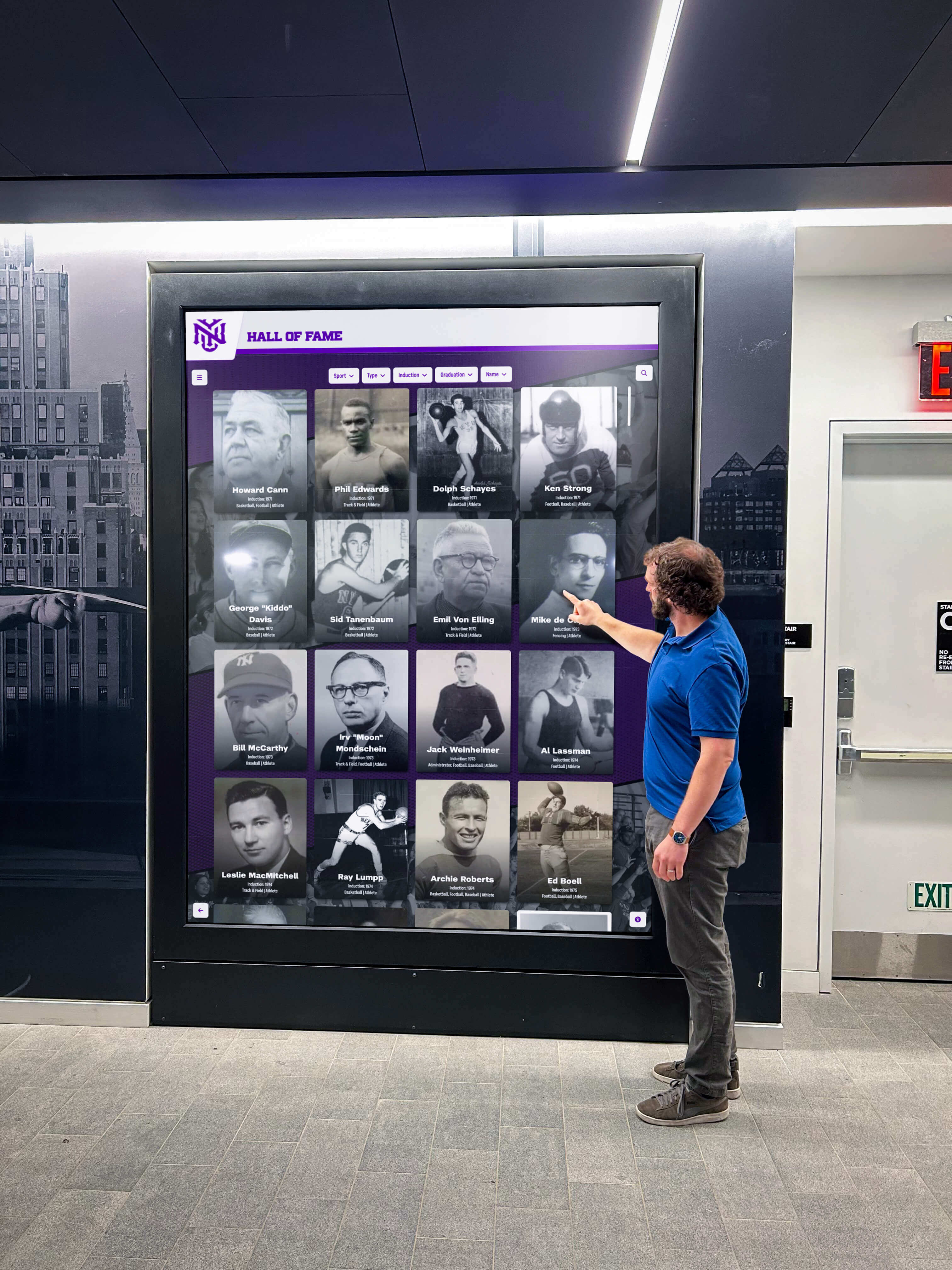
Special Considerations for Elite Basketball Programs
Programs competing at Villanova’s level face unique recognition challenges and opportunities that implementation strategies should address thoughtfully.
Managing Expectations for Continuous Excellence
Championship tradition creates expectations that programs will continue winning at elite levels. Timeline recognition should celebrate past achievement while avoiding creating pressure suggesting anything less than championships represents failure.
Balance historical excellence celebration with recognition of strong seasons that didn’t culminate in championships, individual player development success regardless of team outcomes, conference competition achievements worthy of recognition, and progress indicators showing program trajectory even during rebuilding seasons.
This balanced approach honors tradition while acknowledging that championship-level success represents extraordinary achievement rather than baseline expectation—maintaining healthy perspective about competitive excellence.
Celebrating Players Who Became Professionals
Many elite program alumni continue basketball careers professionally. Timeline content should acknowledge these accomplishments appropriately while maintaining focus on collegiate achievement.
Document professional careers including draft selections and career statistics, highlight NBA success stories inspiring current players, maintain contact with professional alumni for updated information, and feature alumni perspectives on how college experience prepared them for professional success.
These connections between collegiate and professional excellence demonstrate program player development quality while inspiring current student-athletes pursuing similar career paths.
Integrating Academic and Community Success
Championship athletics and academic excellence aren’t mutually exclusive. The most effective timelines celebrate comprehensive student-athlete success including impressive graduation rates and academic honors, community service contributions and leadership initiatives, post-graduation career success across diverse fields, and life lessons learned through basketball applying beyond sport.
Comprehensive success documentation demonstrates that elite basketball programs develop complete individuals rather than solely athletic performance—messaging that resonates with prospective student-athletes and their families evaluating program fit.
The Future of Basketball Timeline Recognition
Digital timeline technology continues evolving with emerging capabilities promising even richer historical experiences.
Augmented Reality Integration
AR capabilities available through smartphone applications will enable visitors to point devices at physical locations and see historical overlays showing championship celebrations in specific spaces, access location-specific historical information triggered by positioning, view historical photographs overlaid on current environments, and explore virtual reconstructions of memorable games and moments.
These immersive experiences make history tangible for technology-native generations while providing novel ways to explore basketball heritage that traditional displays cannot match.
AI-Powered Discovery and Personalization
Artificial intelligence integration will enable natural language search asking questions like “show me all championship game highlights” or “find players from Philadelphia,” automated content recommendations based on viewing patterns, intelligent connections suggesting related content visitors might find interesting, and voice control improving accessibility and ease of use.
These intelligent features make comprehensive historical databases more accessible by meeting users where they naturally communicate rather than requiring mastery of specific navigation patterns.
Social Media Integration
Enhanced social connectivity will feature one-click sharing of historical discoveries to personal networks, community contribution interfaces welcoming photos and memories from fans, collaborative verification where community members suggest corrections, and trending content highlighting what fans are currently exploring and discussing.
This social dimension transforms historical preservation from institutional project into collaborative community effort while extending timeline reach far beyond those who physically visit athletic facilities.
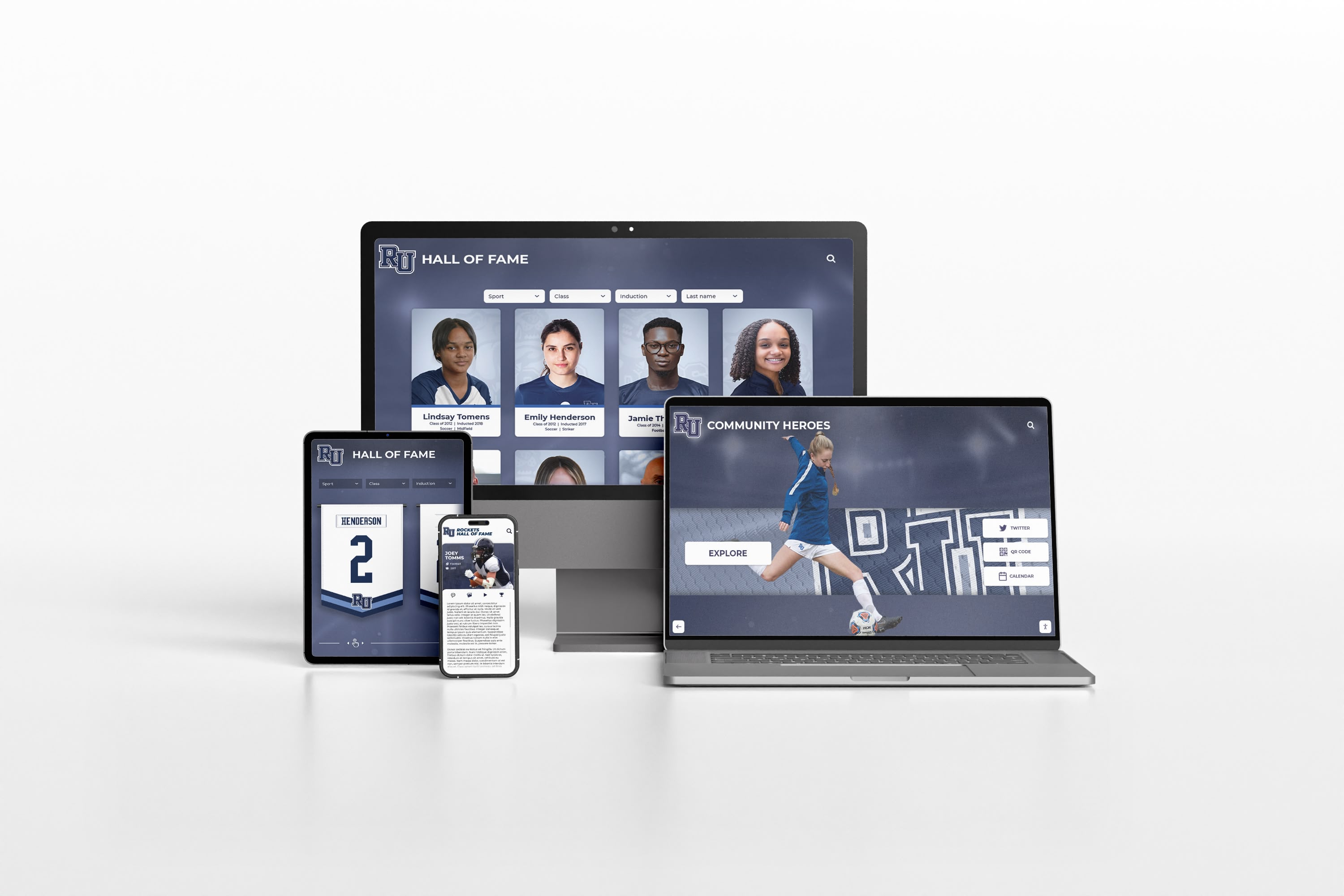
Getting Started: Your Basketball Timeline Implementation Roadmap
Programs ready to implement interactive basketball timeline recognition benefit from systematic approaches ensuring successful deployment.
Months 1-2: Discovery and Planning
Conduct comprehensive inventory of existing historical materials across athletic department locations. Form planning committee including athletic administrators, communications staff, former players, and institutional advancement representatives. Define clear objectives identifying primary audiences and desired outcomes. Develop preliminary budget and identify funding sources including operating budgets, development campaigns, or alumni giving initiatives.
Months 2-4: Research and Content Development
Digitize priority historical materials beginning with championship seasons and at-risk items. Conduct alumni outreach requesting photographs, memorabilia, and memories. Organize content using consistent standards enabling efficient timeline development. Research available technology platforms evaluating features, support quality, and athletic program experience.
Months 4-6: Technology Selection and Installation
Request demonstrations from qualified vendors and check references from similar programs. Make platform selection and secure necessary approvals and funding. Install display hardware in strategic athletic facility locations. Configure software systems and establish content management workflows. Train designated staff on ongoing content management and maintenance.
Months 6-8: Content Loading and Launch
Load comprehensive initial content spanning complete program history. Create featured content sections highlighting championship seasons and legendary players. Implement search functionality and navigation systems. Conduct soft launch for testing and refinement. Execute public launch during high-visibility event like season opener or alumni weekend.
Ongoing: Expansion and Optimization
Monitor engagement analytics identifying popular content and opportunities. Gather community feedback through surveys and unsolicited comments. Continuously expand coverage adding new achievements and newly discovered historical materials. Integrate timeline promotion into recruiting visits, alumni events, and fan engagement. Celebrate milestones and promote discoveries through athletic communications and social media.
Conclusion: Honoring Basketball Excellence Through Modern Recognition
Villanova basketball’s championship legacy—from the perfect 1985 game through dramatic 2016 buzzer-beater to dominant 2018 excellence—represents extraordinary achievement deserving comprehensive celebration that inspires current players while strengthening alumni connections and institutional pride. Traditional recognition methods serving programs adequately for generations now face fundamental limitations including space constraints preventing comprehensive achievement documentation, static displays becoming quickly outdated, limited storytelling capacity, and restricted accessibility beyond campus visitors.
Interactive timeline displays transform basketball recognition from space-constrained static plaques into engaging digital experiences celebrating complete program histories. Unlimited capacity ensures recognition for every deserving player and achievement. Rich multimedia storytelling brings championship moments to life through video, photos, and detailed narratives. Interactive exploration enables personalized discovery matching individual interests. Instant updates celebrate current excellence while enthusiasm remains high.
The most successful implementations combine comprehensive historical content with intuitive navigation, balance statistical depth with compelling narratives, integrate strategically with recruiting and development priorities, and maintain timelines as living resources growing continuously rather than static monuments frozen at specific moments.
Whether programs operate at Villanova’s elite championship level or aspire to build similar traditions, digital basketball timeline recognition delivers measurable value through enhanced player motivation, preserved institutional memory, strengthened program identity, improved recruiting, and deeper community connections spanning generations of players, coaches, and fans.
Modern digital recognition solutions like those from Rocket Alumni Solutions enable basketball programs to honor excellence through intuitive platforms designed specifically for athletic recognition. These systems combine unlimited recognition capacity with simple content management, creating professional displays that inspire current student-athletes while preserving program history for future generations.
Discover how college football hall of fames and other elite athletic programs leverage similar recognition technology, or explore comprehensive approaches to celebrating athletic excellence through digital displays that serve current athletes, alumni, and prospective student-athletes simultaneously.
Your basketball program’s championship moments, legendary players, and decades of competitive excellence deserve recognition matching the significance of these achievements—permanent, professional, engaging, and accessible to everyone who values basketball tradition. Interactive timeline displays make comprehensive celebration finally possible, honoring past excellence while inspiring future champions pursuing their own place in continuing tradition.
